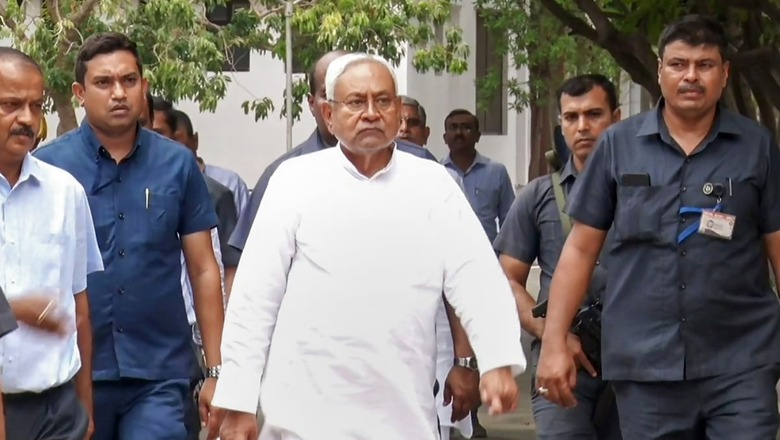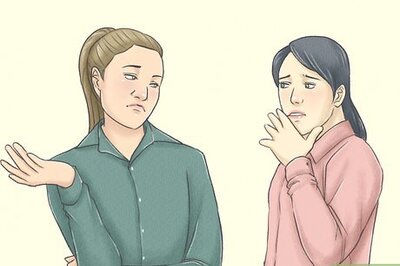
views
Hours after tabling the Caste Survey report in the assembly, the Bihar Cabinet on Tuesday passed a proposal to raise the quota for SCs, STs, Other Backward Classes, Extremely Backward Classes, and Economically Weaker Sections (EWS) to a total of 75 per cent from the existing 50 per cent. A bill will be brought in the assembly during the ongoing session, possibly this week according to sources in the cabinet.
Chief Minister Nitish Kumar made a statement in this regard while concluding the debate on the Caste Survey report. Kumar’s announcement comes months ahead of the 2024 Lok Sabha elections.
The proposal seeks to hike the reservation of OBCs and EBS to a combined 43 per cent from 30 per cent, 20 per cent for SCs from 16 per cent and 2 per cent for STs from 1 per cent. The quota for EWS will remain at the existing 10 per cent. The report revealed that OBCs (27.13 per cent) and the extremely backward classes sub-group (36 per cent) account for a whopping 63 per cent of the state’s total of 13.07 crore, while SCs and STs together were slightly over 21 per cent.
According to the report tabled in the assembly by Parliamentary Affairs Minister Vijay Kumar Chaudhary, the state is home to about 2.97 crore families out of which more than 94 lakh (34.13 per cent) live on an income of Rs 6,000 or less a month, which translates to Rs 200 a day or less a month. While comparable data for current year for household incomes in other states was not readily available, figures gleaned from the statistical appendix to the Economic Survey 2022-23 showed that Bihar had the lowest per capita income of Rs 49,470 a year in the country. Delhi had the highest per capita income from among states at Rs 4.01 lakh.
The report revealed that OBCs (27.13 per cent) and the extremely backward classes sub-group (36 per cent) accounted for a whopping 63 per cent of the state’s total of 13.07 crore, while SCs and STs together were slightly over 21 per cent. Kumar said his government is planning to provide an assistance of Rs 2 lakh each to these 94 lakh families for taking up some form of economically productive work.
Besides, his government planned to give Rs 1 lakh to each family identified as having no house to live in for construction of habitats, the chief minister said. “If we get the special category status (for Bihar), we will be able to achieve our goals in two to three years. Otherwise, it may take much longer”, said Kumar.
The percentage of households with similar earnings among the Scheduled tribe households (42.91 per cent) was almost the same as among scheduled caste families (42.78 per cent), according to the report. The report has also come out with several other important findings like more than 50 lakh people of Bihar are living outside the state in search of livelihood or better education opportunities.
The most well-off Hindu upper caste were the numerically minuscule Kayasthas as only 13.83 per cent of families from the largely urbanised community live on such an income. The same ratio is surprisingly high for the Bhumihars (27.58), believed to be the biggest land-owning caste of Bihar, who dominated the state’s politics until the Mandal wave of the 1990s threw up a new power structure.
The report revealed that despite their political ascendance, more than 35 per cent of Yadavs have a monthly income ceiling of Rs 6000. Among the Kurmis, the caste to which Chief Minister Nitish Kumar belongs, nearly 30 per cent of people earn a similar amount.
The survey also took into account the caste divisions among Muslims, who together accounted for more than 17 per cent of the state’s population. It said that 17.61 per cent of the Sayyads, who claim descent from the family of the Prophet, earn Rs 6000 per month or less. On the education front, the report said there are nearly 80 lakh graduates in the state, which is around 6.11 per cent of the total population.
According to the report, 24,534 people belonging to Other Reported Classes (ORC) have the maximum number of graduates, accounting for 13.45 per cent of their total population. This is followed by 26,95,820 graduates from the general category, which is 13.41 per cent of their total count, the report said, adding altogether there are 7,83,050 Scheduled Caste graduates, which is a meagre 3.05 per cent of their total population.
The total number of postgraduates is 10,76,700, which is 0.82 per cent of the population, the report said. The number of people having PhDs, including chartered accountants, is 95,398, which is 0.07 per cent of the population. The report said only 15 lakh people have their own laptops, with regular internet connections, which is not even two per cent of the population surveyed.
“In all, 15,08,085 have their own laptops, with regular internet connections. This is 1.15 per cent of the total 13,07,25,310 people surveyed,” it added. In all, 10,147 people belonging to the ORC have laptops with internet, which is 5.56 per cent of their total population, followed by 6,33,864 belonging to general category, which is 3.15 per cent of their total population, the report added.
In all 95,490 people belonging to Scheduled Castes (SCs) have laptops with internet connection (0.37 per cent), the report said. Around 99.49 per cent people (2,55,59,507) belonging to SC category have no access to laptops, it added. Kumar’s comment on the importance of women’s education to control the population raised a storm on Tuesday with the opposition BJP tearing into him.
Emphasising the importance of education among women to control the population, Kumar put forward a vivid description in the assembly of how an educated woman can restrain her husband during sexual intercourse. “The husband’s acts led to more births. However, with education, a woman knows how to restrain him… this is the reason the numbers (of births) are coming down,” he said in a rustic style.
“You, journalists also understand it well. Earlier it (fertility rate) was 4.3, but it has now reached 2.9. And, soon we will reach 2,” he added. The opposition BJP charged Kumar with “bringing shame” to the state’s women by speaking of the procreation process in detail.
BJP MLAs Gayatri Devi and Sweety Hembram told reporters that “age has caught up with the chief minister who seems to have lost all sense of propriety”.




















Comments
0 comment